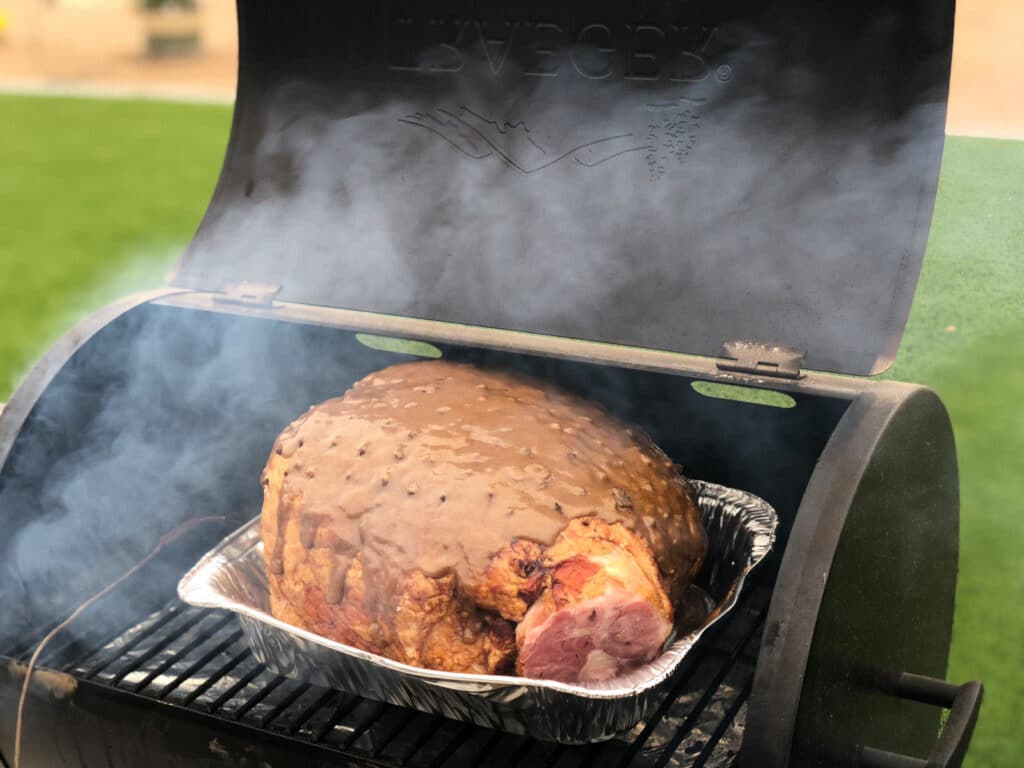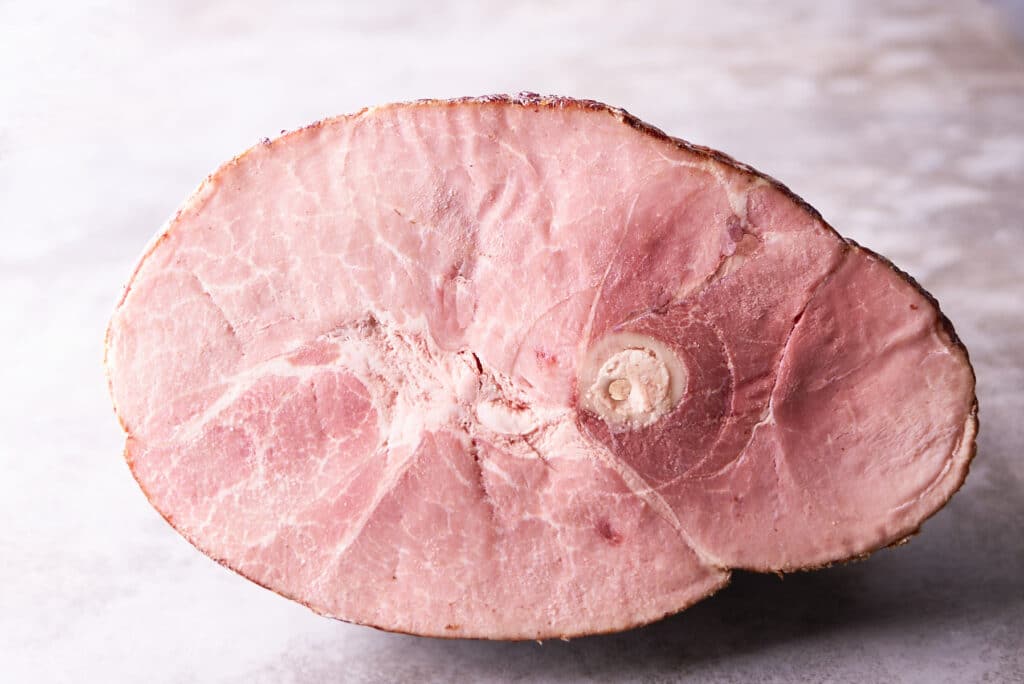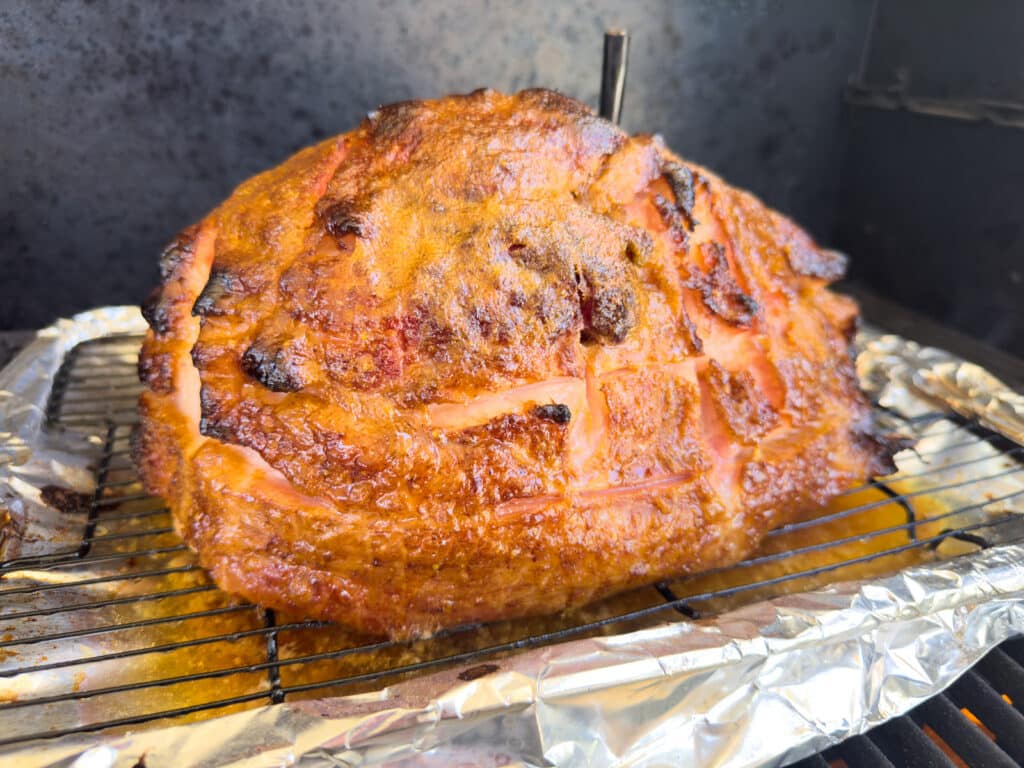I’ve been a fervent admirer of Snake River Farms’ exceptional products for years. Their unwavering commitment to quality, sustainability, and animal welfare has resonated deeply with me. When they extended an invitation to review their Kurobuta Ham (click to learn more), I eagerly accepted, eager to embark on a culinary adventure.
A Premium Pork Experience: Unveiling Kurobuta Ham
Before delving into the preparation and enjoyment of this exquisite ham, let’s take a moment to understand its unique origins. Kurobuta ham derives from Berkshire pigs, a heritage breed renowned for their rich marbling and exceptional flavor. The Japanese term Kurobuta means “black hog” and refers to the Berkshire breed. These pampered pigs are raised on small family farms, where they roam freely, indulge in natural diets, and receive humane treatment. This meticulous approach results in Kurobuta pork, which is prized for its unparalleled tenderness, juiciness, and depth of flavor.

Unveiling the Kurobuta Ham: A Journey from Frozen to Flavored Masterpiece
As my anticipation grew, I eagerly awaited the arrival of my frozen Kurobuta ham (click to learn more). Upon its delivery, I was impressed by Snake River Farms’ meticulous packaging, ensuring the ham’s journey from their farms to my kitchen remained intact. The ham arrived nestled in a reusable thermal bag, surrounded by dry ice, and enclosed in an eco-friendly insulated box.
After carefully thawing the ham according to the instructions provided, I eagerly examined its exquisite appearance. The ham’s surface gleamed with a rich mahogany hue, its marbling hinting at the burst of flavors that awaited. The aroma that wafted from the ham was a tantalizing prelude to the culinary delights that lay in store.
Preparing the Kurobuta Ham: A Symphony of Heat and Time
With anticipation reaching its crescendo, I embarked on the culinary journey of preparing the Kurobuta ham (click to learn more). Adhering to the detailed instructions provided by Snake River Farms, I carefully placed the ham in a roasting pan and adorned it with a fragrant blend of spices. The ham graced my smoker, where the gentle caress of heat began to transform it into a culinary masterpiece.
As the minutes ticked by, the aroma that enveloped my kitchen grew more enticing, teasing my senses with promises of culinary delight. The ham’s surface began to caramelize, its glistening exterior hinting at the succulent flavors within.

The Culinary Culmination: Carving and Savoring the Kurobuta Ham
Finally, the moment of truth arrived. With eager hands, I removed the ham from the oven, allowing it to rest before embarking on the art of carving. As I gently sliced through the ham, I marveled at its exquisite texture, each slice revealing a symphony of marbling and color.
The first bite was a revelation. The ham’s tenderness was unparalleled, melting effortlessly on my tongue. The flavors were a harmonious blend of savory, sweet, and subtle smokiness, each note complementing the other in perfect unison. The marbling, the hallmark of Kurobuta pork, infused each morsel with an unparalleled juiciness, leaving my palate captivated and longing for more.
The Kurobuta Ham: A Culinary Masterpiece Worth Every Penny
As I savored the final morsels of the Kurobuta ham (click to learn more), I was filled with a sense of culinary satisfaction. This ham was not just a meal; it was an experience, a journey of flavors and textures that elevated my dining experience to new heights. While the Kurobuta ham carries a premium price tag, its unparalleled quality and taste justify the culinary experience.

Is the ham cooked or uncooked?
The Snake River Farms’ Korubuta Ham (click to learn more) like most hams purchased in the grocery store, is typically fully cooked. However, you’ll still need to heat it throughly before serving. This will help to ensure that it’s safe to eat and that it has the best flavor.
If the ham is cooked, are we just rewarming it?
That is a great question! Since the ham is cured and smoked over real hardwood, you are, in essence, rewarming the ham; therefore, you want to avoid overcooking and drying out your ham. Additionally, unless I’m planning on serving the entire ham all at once or want a showstopping presentation, I usually only cut away the portion of ham I need. That allows me to use only reheat the ham I need without worrying about drying out the rest.

Thawing:
The journey to ham perfection begins with proper thawing. Allow your frozen ham to thaw in the refrigerator for approximately 24-48 hours, depending on the size. Place the ham in a sink or large food-safe storage container filled with water and a Boss Defrost (click to learn more) for a more controlled thaw.
Prepping for the Oven, Grill, or Smoker:
Once thawed, remove the ham from its packaging and pat it dry with paper towels. It’s not needed, but if you want that classic ham look, score the ham’s fat cap, creating a diamond pattern to allow the rendered fat to baste the meat during cooking.
Enhancing the Flavor:
The Snake River Farms’ Korubuta Ham (click to learn more) is packed with flavor and doesn’t need it, but if you want to upgrade it, I recommend a simple glaze. Generously rub the ham with a combination of your favorite spices, such as brown sugar, Dijon mustard, and a touch of paprika. This will not only enhance the flavor but also create a delightful caramelized exterior.
The Roasting Process:
Preheat your oven, grill, or smoker to 325°F (165°C). Place the Snake River Farms’ Kurobuta Ham (click to learn more) fat side up in a roasting pan or rimmed baking sheet. If cooking a half ham, place the flat side down in the roasting pan.
Roasting Time:
Estimate the roasting time based on the ham’s weight:
- 10-15 pounds: 2½-3½ hours
- 15-20 pounds: 3½-4½ hours

Basting and Glazing:
During the last 30 minutes of cooking, baste the ham with its pan juices. For a touch of sweetness and shine, prepare a glaze by combining brown sugar, honey, and a touch of pineapple juice. Brush the glaze generously over the ham during the last 15 minutes of cooking.
Internal Temperature and Resting:
Use a meat thermometer to check the internal temperature of the ham, ensuring it reaches 140°F (60°C) for fully cooked hams and 160°F (71°C) for uncooked hams. Once cooked, remove the ham from the oven and let it rest for 15-20 minutes, allowing the juices to redistribute for optimal tenderness.
Temperature Perfection: The Art of Precision
To ensure your ham is cooked or reheated to perfection, use a meat thermometer and aim for these internal temperatures:
- Cooked ham: 140°F (60°C)
- Uncooked ham: 160°F (71°C)
- Reheated ham: 140°F (60°C)
- Place the ham on a carving board with the fat side up.
- Use a sharp knife to make a deep incision down the center of the ham, following the bone.
- Cut the ham into slices, following the bone.
- Once you’ve reached the bone, carefully remove it and discard it.
- Continue cutting the ham into slices until you’ve reached the other side.
- Serve the ham immediately.
Carve your masterpiece with confidence
- Place the Kurobuta Ham on a carving board with the fat side up.
- Use a sharp knife to make a deep incision down the center of the ham, following the bone.
- Cut the ham into slices, following the bone.
- Once you’ve reached the bone, carefully remove it and discard it.
- Continue cutting the ham into slices until you’ve reached the other side.
- Serve the ham immediately.

5 Best Ways to Reheat Ham Leftovers
While a freshly cooked ham is a culinary delight, leftovers can be equally satisfying when reheated properly. Ham leftovers are a delicious and versatile meal option. They can be used in sandwiches, salads, soups, and more. But the best way to reheat ham leftovers is important to ensure that they stay moist and flavorful. Here are five of the best ways to reheat ham leftovers:
1. Oven: Reheating ham in the oven is a great way to ensure that it stays moist and juicy. Preheat your oven to 325 degrees Fahrenheit (165 degrees Celsius) and place the ham on a baking sheet. Add a splash of water or broth to the pan to prevent the ham from drying out. Cover the ham with foil and bake for 10-15 minutes per pound, or until it reaches an internal temperature of 140 degrees Fahrenheit (60 degrees Celsius).
2. Stovetop: Reheating ham on the stovetop is a quick and easy option. Heat a tablespoon of oil or butter in a skillet over medium heat. Add the ham to the skillet and cook for 2-3 minutes per side, or until heated through. Be sure to add a splash of water or broth to the skillet to prevent the ham from drying out.
3. Microwave: Reheating ham in the microwave is the fastest and easiest option. Place the ham on a microwave-safe plate and add a splash of water or broth. Cover the ham with plastic wrap and microwave on high for 1-2 minutes per slice, or until heated through.
4. Slow cooker: Reheating ham in the slow cooker is a great way to keep it moist and juicy. Place the ham in the slow cooker and add a cup of water or broth. Cover the slow cooker and cook on low for 4-6 hours, or until the ham is heated through.
5. Air fryer: Reheating ham in the air fryer is a quick and easy way to get a crispy crust. Preheat your air fryer to 350 degrees Fahrenheit (175 degrees Celsius) and place the ham in the air fryer basket. Cook for 5-7 minutes per side, or until heated through.
Tips for reheating ham leftovers:
- No matter which reheating method you choose, be sure to add a splash of water or broth to the ham to prevent it from drying out.
- Don’t overcook the ham, or it will become dry and tough.
- If you’re reheating a large ham, cut it into slices before reheating. This will help it heat through evenly.
- Serve the ham immediately with your favorite sides.
Hamtastic Conclusion: A Culinary Journey Concluded
With these tips and techniques in your culinary arsenal, you’re well on your way to mastering the art of cooking and reheating a whole ham. Whether it’s a centerpiece for a holiday feast or a comforting dish for a family dinner, your ham will undoubtedly be a showstopping success.

Snake River Farms’ Kurobuta Ham with a Pineapple Clove Glaze
Ingredients
- 1 Snake River Farms' Kurobuta Ham
- 1/2 cup brown sugar
- 1/4 cup honey
- 1/4 cup pineapple juice
- 1 teaspoon ground cloves
- 1 teaspoon whole cloves
- 1/4 teaspoon black pepper
Instructions
- In a small saucepan, combine all ingredients (except the whole cloves) and whisk until well combined.
- Bring the glaze to a simmer over medium heat and cook for 5-7 minutes or until thickened.
- Remove the glaze from the heat and let it cool slightly.
- To glaze the ham:
- Preheat the oven to 325 degrees Fahrenheit (165 degrees Celsius).
- Place the Kurobuta Ham (click to learn more) in a roasting pan brush it with the glaze and stud it with the whole cloves.
- Bake the ham for 20-30 minutes or until the glaze is bubbly and caramelized.
- Let the Kurobuta Ham (click to learn more) rest for 10-15 minutes before carving and serving.
Video
Notes
Be sure to brush the ham with the glaze every 15-20 minutes to prevent it from drying out.
If the ham starts to get too brown, cover it with foil.
Let the ham rest for 10-15 minutes before carving to allow the juices to redistribute throughout the meat.